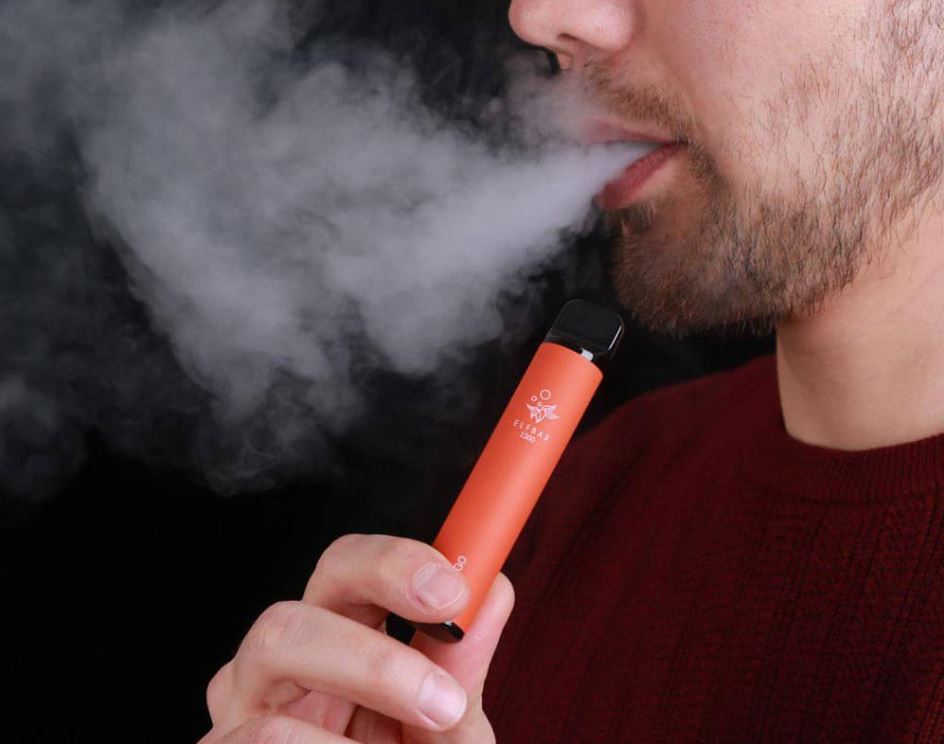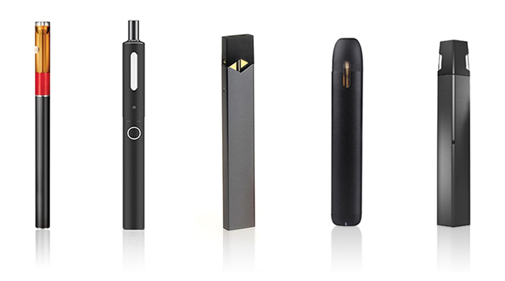|
Electronic Cigarette
An electronic cigarette (e-cigarette), or vape, is a device that simulates smoking. It consists of an atomizer, a power source such as a battery, and a container such as a cartridge or tank. Instead of smoke, the user inhales vapor. As such, using an e-cigarette is often called "vaping". The atomizer is a heating element that vaporizes a liquid solution called e-liquid that cools into an aerosol of tiny droplets, vapor and air. The vapor mainly comprises propylene glycol and/or glycerin, usually with nicotine and flavoring. Its exact composition varies, and depends on matters such as user behavior. E-cigarettes are activated by taking a puff or pressing a button. Some look like traditional cigarettes, and most kinds are reusable. Nicotine is highly addictive. Users become physically and psychologically dependent. Limited evidence indicates that e-cigarettes are less addictive than smoking, with slower nicotine absorption rates. , quote="There is moderate evidence that r ... [...More Info...] [...Related Items...] OR: [Wikipedia] [Google] [Baidu] |
Composition Of Electronic Cigarette Aerosol
The chemical composition of the electronic cigarette aerosol varies across and within manufacturers. Limited data exists regarding their chemistry. However, researchers at Johns Hopkins University analyzed the vape clouds of popular brands such as Juul and Vuse, and found "nearly 2,000 chemicals, the vast majority of which are unidentified." The aerosol of electronic cigarette, e-cigarettes is generated when the construction of electronic cigarettes#E-cigarette liquid, e-liquid comes in contact with a coil heated to a temperature of roughly within a chamber, which is thought to cause pyrolysis of the e-liquid and could also lead to decomposition of other liquid ingredients. The aerosol (mist) produced by an e-cigarette is commonly but inaccurately called vapor. E-cigarettes simulate the action of tobacco smoking, smoking, but without tobacco combustion. The e-cigarette aerosol looks like cigarette smoke to some extent. E-cigarettes do not produce aerosol between puffs. The e-ciga ... [...More Info...] [...Related Items...] OR: [Wikipedia] [Google] [Baidu] |
Construction Of Electronic Cigarettes
An electronic cigarette is a handheld battery-powered vaporizer that simulates smoking, but without tobacco combustion. E-cigarette components include a mouthpiece (drip tip), a cartridge (liquid storage area), a heating element/ atomizer, a microprocessor, a battery, and some of them have an LED light on the end. An atomizer consists of a small heating element, or coil, that vaporizes e-liquid and a wicking material that draws liquid onto the coil. When the user inhales, a flow sensor activates the heating element that atomizes the liquid solution; most devices are manually activated by a push-button. The e-liquid reaches a temperature of roughly within a chamber to create an aerosolized vapor. The user inhales an aerosol, which is commonly but inaccurately called vapor, rather than cigarette smoke. Vaping is different from smoking, but there are some similarities, including the hand-to-mouth action of smoking and an aerosol that looks like cigarette smoke. The aerosol p ... [...More Info...] [...Related Items...] OR: [Wikipedia] [Google] [Baidu] |
Vaporizer (inhalation Device)
A vaporizer or vaporiser, colloquially known as a vape, is a device used to vaporize substances for inhalation. Plant substances can be used, commonly cannabis, tobacco, or other herbs or blends of essential oil. However, they are most commonly filled with a combination propylene glycol, glycerin, and drugs such as nicotine (e.g. extract from tobacco) or tetrahydrocannabinol as a liquid solution. Vaporizers contain various forms of extraction chambers including straight bore, venturi, or sequential venturi, and are made of materials such as metal or glass. The extracted vapor may be collected in an inflatable bag, or inhaled directly through a hose or pipe. When used properly, cooler temperatures due to lack of combustion result in significantly more efficient extraction of the ingredients. Hence, the irritating and harmful effects of smoking are heavily reduced, as is its secondhand smoke. Cannabis vaporizers Cannabis flower is commonly consumed using a dry herb vaporizer. The ... [...More Info...] [...Related Items...] OR: [Wikipedia] [Google] [Baidu] |
Construction Of Electronic Cigarettes
An electronic cigarette is a handheld battery-powered vaporizer that simulates smoking, but without tobacco combustion. E-cigarette components include a mouthpiece (drip tip), a cartridge (liquid storage area), a heating element/ atomizer, a microprocessor, a battery, and some of them have an LED light on the end. An atomizer consists of a small heating element, or coil, that vaporizes e-liquid and a wicking material that draws liquid onto the coil. When the user inhales, a flow sensor activates the heating element that atomizes the liquid solution; most devices are manually activated by a push-button. The e-liquid reaches a temperature of roughly within a chamber to create an aerosolized vapor. The user inhales an aerosol, which is commonly but inaccurately called vapor, rather than cigarette smoke. Vaping is different from smoking, but there are some similarities, including the hand-to-mouth action of smoking and an aerosol that looks like cigarette smoke. The aerosol p ... [...More Info...] [...Related Items...] OR: [Wikipedia] [Google] [Baidu] |
Electronic Cigarette And USB Charger (14939561277) (retouched)
Electronic may refer to: *Electronics, the science of how to control electric energy in semiconductors * ''Electronics'' (magazine), a defunct American trade journal *Electronic storage, the storage of data using an electronic device *Electronic commerce or e-commerce, the trading in products or services using computer networks, such as the Internet *Electronic publishing or e-publishing, the digital publication of books and magazines using computer networks, such as the Internet *Electronic engineering, an electrical engineering discipline Entertainment *Electronic (band), an English alternative dance band ** ''Electronic'' (album), the self-titled debut album by British band Electronic *Electronic music, a music genre *Electronic musical instrument *Electronic game, a game that employs electronics See also *Electronica, an electronic music genre *Consumer electronics Consumer electronics, also known as home electronics, are electronic devices intended for everyday household ... [...More Info...] [...Related Items...] OR: [Wikipedia] [Google] [Baidu] |
Glycerol
Glycerol () is a simple triol compound. It is a colorless, odorless, sweet-tasting, viscous liquid. The glycerol backbone is found in lipids known as glycerides. It is also widely used as a sweetener in the food industry and as a humectant in pharmaceutical formulations. Because of its three hydroxyl groups, glycerol is miscible with water and is Hygroscopy, hygroscopic in nature. Modern use of the word glycerine (alternatively spelled glycerin) refers to commercial preparations of less than 100% purity, typically 95% glycerol. Structure Although chirality, achiral, glycerol is prochirality, prochiral with respect to reactions of one of the two primary alcohols. Thus, in substituted derivatives, the Glycerophospholipid#Nomenclature and stereochemistry, stereospecific numbering labels the molecule with a ''sn''- prefix before the stem name of the molecule. Production Natural sources Glycerol is generally obtained from plant and animal sources where it occurs in triglycerides, est ... [...More Info...] [...Related Items...] OR: [Wikipedia] [Google] [Baidu] |
Nicotine Salt
Nicotine salts are salts formed from nicotine and an acid. They are found naturally in tobacco leaves. Various acids can be used, leading to different conjugate bases paired with the ammonium form of nicotine. Research Research on nicotine salts is limited. Possible health risks of persistent inhalation of high levels of nicotine salts are not fully known. "Juul products use nicotine salts, which can lead to much more available nicotine," Principal Deputy Director Dr. Anne Schuchat of the Centers for Disease Control and Prevention (CDC) stated in September 2019. She also stated that the nicotine salts "cross the blood brain barrier and lead to potentially more effect on the developing brain in adolescents." Types A nicotine base and a weak acid such as benzoic acid or levulinic acid is used to form a nicotine salt. Across a sample of 23 nicotine salts available for public purchase, the three most common acids used in the formation of nicotine salts were lactic acid, benzoic ac ... [...More Info...] [...Related Items...] OR: [Wikipedia] [Google] [Baidu] |
Free Base
In chemistry, a free base (freebase, free-base) is a term for the neutral form of an amine or other Lewis base. The term is used in the pharmaceutical industry in contrast to salt-based formulations like hydrochlorides. The amine is often an alkaloid, such as nicotine, cocaine, morphine, and ephedrine, or derivatives thereof. Colloquially, "free-basing" also means the treatment of salts or other formulations to convert them into the free base form, especially for recreational drugs. Properties Some alkaloids are more stable as ionic salts than as free base. The salts usually exhibit greater water solubility. Common counterions include chloride, bromide, sulfate, phosphate, nitrate, acetate, oxalate, citrate, and tartrate. Amine salts formed from the acid–base reaction with hydrochloric acid are known as hydrochlorides. For example, compare the free base hydroxylamine (NH2OH) with the salt hydroxylamine hydrochloride (NH3OH+ Cl−). Freebasing Cocaine hydrochloride ("p ... [...More Info...] [...Related Items...] OR: [Wikipedia] [Google] [Baidu] |
Food And Drug Administration
The United States Food and Drug Administration (FDA or US FDA) is a List of United States federal agencies, federal agency of the United States Department of Health and Human Services, Department of Health and Human Services. The FDA is responsible for protecting and promoting public health through the control and supervision of food safety, tobacco products, caffeine products, dietary supplements, Prescription drug, prescription and Over-the-counter drug, over-the-counter pharmaceutical drugs (medications), vaccines, biopharmaceuticals, blood transfusions, medical devices, electromagnetic radiation emitting devices (ERED), cosmetics, Animal feed, animal foods & feed and Veterinary medicine, veterinary products. The FDA's primary focus is enforcement of the Federal Food, Drug, and Cosmetic Act (FD&C). However, the agency also enforces other laws, notably Section 361 of the Public Health Service Act as well as associated regulations. Much of this regulatory-enforcement work is ... [...More Info...] [...Related Items...] OR: [Wikipedia] [Google] [Baidu] |
Flavoring
A flavoring (or flavouring), also known as flavor (or flavour) or flavorant, is a food additive that is used to improve the taste or smell of food. It changes the perceptual impression of food as determined primarily by the chemoreceptors of the gustatory and olfactory systems. Along with additives, other components like sugars determine the taste of food. A flavoring is defined as a substance that gives another substance taste, altering the characteristics of the solute, causing it to become sweet, sour, tangy, etc. Although the term, in common language, denotes the combined chemical sensations of taste and smell, the same term is used in the fragrance and flavors industry to refer to edible chemicals and extracts that alter the flavor of food and food products through the sense of smell. Owing to the high cost, or unavailability of natural flavor extracts, most commercial flavorings are "nature-identical", which means that they are the chemical equivalent of natural ... [...More Info...] [...Related Items...] OR: [Wikipedia] [Google] [Baidu] |
Organic Certification
Organic certification is a certification process for producers of organic food and other organic agricultural products.Labelling, article 30 o''Regulation (EU) 2018/848 of the European Parliament and of the Council of 30 May 2018 on organic production and labelling of organic products and repealing Council Regulation (EC) No 834/2007.''/ref> In general, any business directly involved in food production can be certified, including seed suppliers, farmers, food processors, retailers and restaurants. A lesser known counterpart is certification for organic textiles (or organic clothing) that includes certification of textile products made from organically grown fibres. Requirements vary from country to country ( List of countries with organic agriculture regulation), and generally involve a set of production standards for growing, storage, processing, packaging and shipping that include: * avoidance of synthetic chemical inputs (e.g. fertilizer, pesticides, antibiotics, food ad ... [...More Info...] [...Related Items...] OR: [Wikipedia] [Google] [Baidu] |









